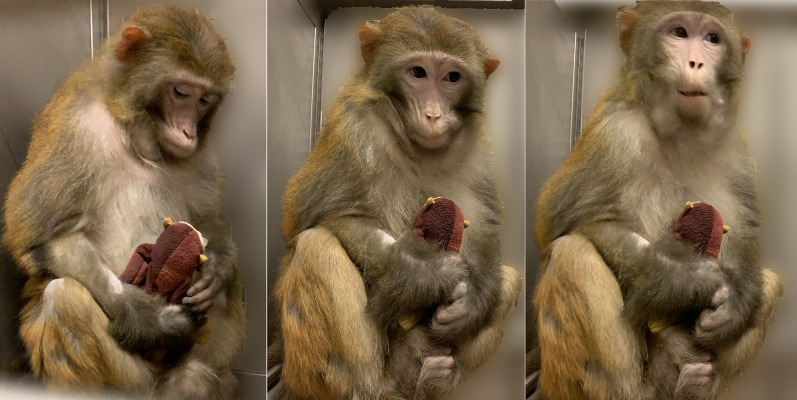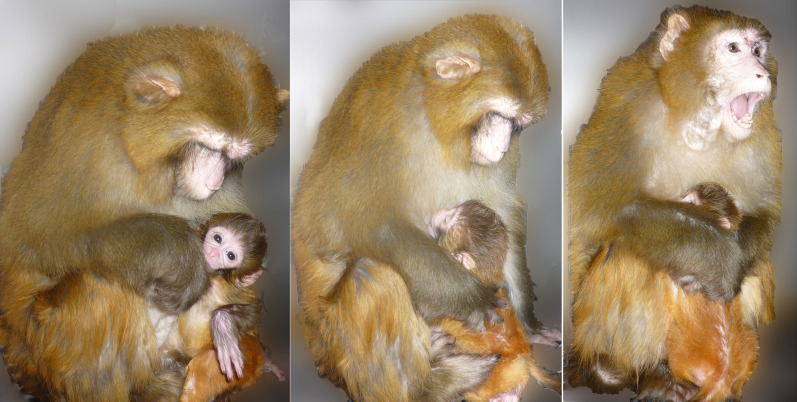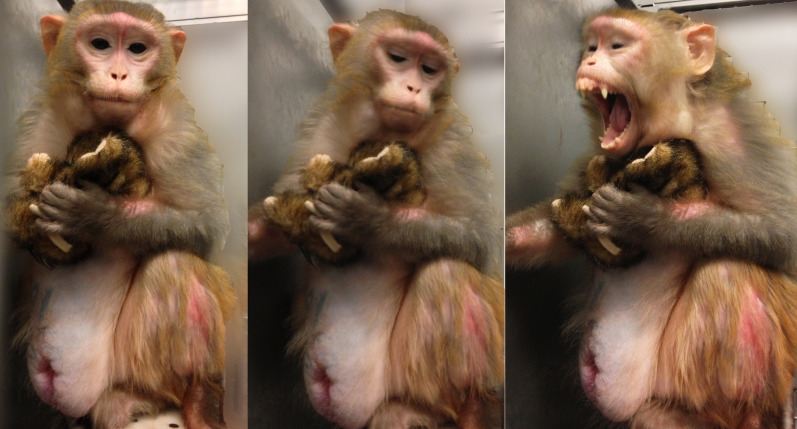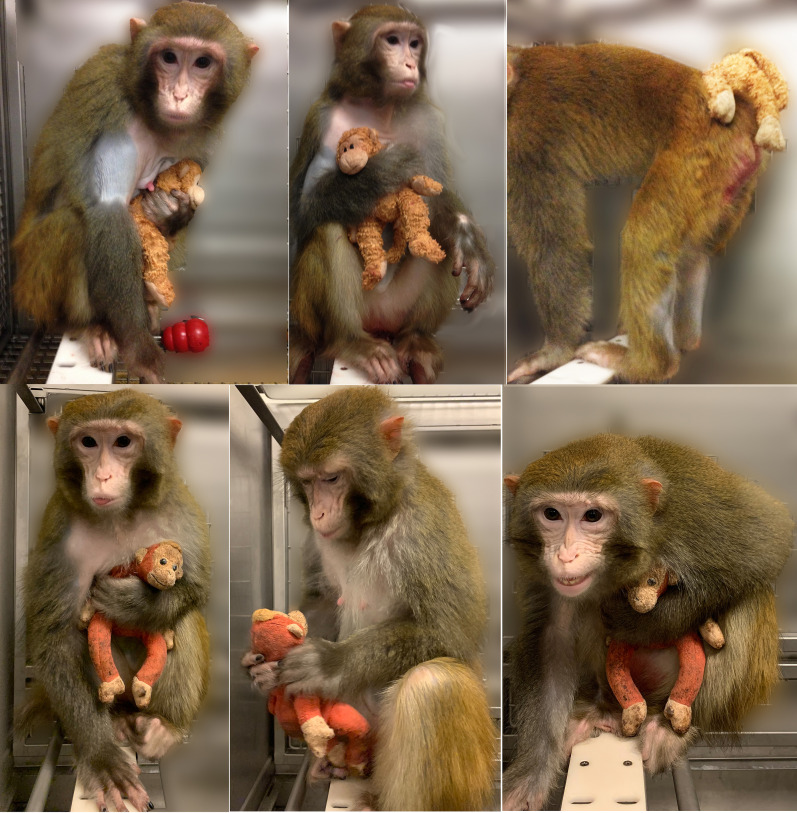Significance
Harry Harlow found that infant monkeys form strong and lasting attachments to inanimate surrogates, but only if the surrogate is soft; here I report that postpartum monkey mothers can also form strong and lasting attachments to soft inanimate objects. Thus, mother/infant and infant/mother bonds may both be triggered by soft touch.
Keywords: maternal bonding, attachment, bonding
Abstract
Previous studies showed that baby monkeys separated from their mothers develop strong and lasting attachments to inanimate surrogate mothers, but only if the surrogate has a soft texture; soft texture is more important for the infant’s attachment than is the provision of milk. Here I report that postpartum female monkeys also form strong and persistent attachments to inanimate surrogate infants, that the template for triggering maternal attachment is also tactile, and that even a brief period of attachment formation can dominate visual and auditory cues indicating a more appropriate target.
Before the 1900s, affection and religion were thought to be the most important factors in child rearing, but starting around 1910 and lasting for at least 30 y there was a major shift toward cleanliness, order, and scientific principles of conditioning and training, motivated by the new behaviorist theory in psychology (1). A survey (2) of the advice found in popular women’s magazines during that era summarized the Zeitgeist as the following:
Mothers were admonished to insist upon obedience at all times, and if temper tantrums resulted, they should be ignored. Together with a more severe attitude toward the child went a new taboo on physical handling. Love, and particularly the physical manifestation of it, was discouraged in most of the articles on infant Disciplines. It was believed that stimulation of any sort would lead to precocity in the older child and dullness in the man. Furthermore, baby’s strength was needed for rapid growing, and picking the baby up deprived him of his strength. Still another reason for discouraging physical contact with baby was the belief that postnatal conditions for the infant should closely approximate prenatal conditions, and since the infant was not handled in the uterus, he should not be handled after birth.
Watson wrote (3): “There are serious rocks ahead for the overkissed child.” I distinctly remember in the early 1950s my grandfather admonishing my mother not to “coddle” me; I remember because I thought that was something you did to eggs.
This hands-off view led to sterile, contactless nurseries across many countries. Holding and touching of premature infants or even visiting hospitalized children was generally forbidden, on the grounds that it spread diseases. Orphanages and other children’s institutions varied but often adhered to this trend, some even keeping infants in isolated cubicles to prevent the spread of infections. However, in the 1940s evidence began amassing that such institutionalization, or prolonged hospitalization, could hinder children’s growth and lead to severe psychological problems (4–6). Both my collaborator, David Hubel, and my husband recollect being hospitalized as young children and not allowed visitors; their mothers could only wave to them through a window in the door. Both found it traumatizing.
Thus, the importance of infant/caregiver attachment began to be recognized, but its biological basis was disputed. The prevailing, behaviorist, view among psychologists and sociologists was that this attachment derived from a learned association between the mother and hunger satiation (7). A less popular theory was that humans and animals have fundamental innate drives beyond the physiological drives of discomfort and hunger, and these drives include attachment to a mother figure (Fig. 4).
Fig. 4.
Monkey B2 still carrying her toy 2 mo after parturition. She is the same monkey as the infant in Fig. 1. On the evening of the day of parturition she retained this toy in preference to her own live infant.
Innate visual and auditory triggers underlie imprinting in hatchling birds, which leads to persistent following responses (8), but almost nothing was known about innate mechanisms responsible for the strong and lasting ties mammalian infants form with their mothers. Gertrude Van Wagenen (9) observed that infant macaques, separated from their mothers and fed from tiny nursing bottles, would not feed properly unless they could cling to a soft towel (see also ref. 10). Harry Harlow adopted the towel technique for raising infant macaques and found that they developed strong attachments to the towels and were distressed when the cloths were removed for cleaning (11). These laboratory-reared monkeys were larger and healthier and had a higher survival rate than infants left to the care of their monkey mothers, as long as they had a soft cloth; without the cloth, survival was lower.
To try to disentangle the relative importance of vision, touch, warmth, and nourishment for establishing infant bonding, Harlow and Zimmermann (12) constructed various mother surrogates for infant macaques. Some surrogates were soft and others rigid and unyielding, with or without faces, heated or not, with or without an attached milk bottle. Infants provided with two different surrogates overwhelmingly preferred the cloth surrogate over the rigid surrogate, irrespective of which provided milk or heat or had a face. Infants displayed strong sustained attachment to and derived security from cloth surrogates for more than a year and a half (the duration of the experiment). Infants’ attachment to and behavior toward the cloth surrogates was indistinguishable from mother-reared infants’ attachment to their monkey mothers (11). The parallels between the abnormal behaviors of macaque infants reared without any cloths or soft surrogates (13) and the psychological problems often found in children who as infants had been reared in sterile cubicles (4) were instrumental in changing child-rearing practices and hospital visiting rules (14).
Beyond its social importance, Harlow’s work shows that infant monkey attachment is based on surprisingly few sensory features, i.e., primarily tactile, and may be established within only a limited time during development, as in imprinting. The complementary attachment, of mothers to their offspring, though widely acknowledged in literature and art, is not much studied. In rodents, olfactory and auditory cues emitted by pups trigger maternal behavior in hormonally primed females (15). Mother ewes form selective attachments to their own lambs via olfactory imprinting (16). Almost nothing is known about the sensory cues involved in generating the strong and lasting attachment of primate mothers to their infants (17). Macaque mothers hold and protect their infants continuously after birth and carry them around, groom them, and treat them protectively for many months (Fig. 1). Given the complex social organization of this species (18), massive visual system with specialized visual domains, comparable to those in humans, for face and body recognition (19), and auditory domains specific for monkey vocalizations (20), one might expect that multiple, complex sensory cues would be involved in mother macaques bonding with their infants.
Fig. 1.
Typical maternal behavior of a rhesus macaque. Female is holding (Left), nursing (Center), and protecting her infant from the perceived threat of the author coming near her enclosure (Right). Most monkeys in our colony respond to familiar humans by indicating a desire for a scratch or expectation of a treat; mothers with infants are extra-defensive (10, 18) and will initially show aggression for a few seconds then calm down and accept treats. The infant in these photos is monkey B2, whose behavior as an adult is described below.
Here I report some observations that indicate that primate maternal attachment to the infant may not depend on complex multisensory cues but rather that a single sufficient trigger for maternal behavior (in a hormonally primed female) is tactile. My first observation was of an 8-y-old primiparous female rhesus macaque, monkey Ve. She delivered a stillborn infant. She was holding the lifeless infant to her chest when I first observed her in the morning.* Appropriate veterinary care required that the dead infant be removed and examined, and to accomplish this, she was lightly anesthetized. When she recovered a few minutes later, she exhibited significant signs of distress: She vocalized loudly and constantly and seemed to be searching agitatedly around her enclosure. Other monkeys housed in the same room also began to vocalize and became agitated. To try to reduce the level of stress in the room I placed a stuffed animal in her enclosure. It was a 15-cm-tall, soft, furry toy, a faceless stuffed mouse, chosen because of its availability and its lack of potential choking hazards, such as sewn-on eyes. Monkey Ve immediately picked up the stuffed toy and held it to her chest. She stopped screeching and became calm while holding it, and the whole room quieted down. She held the toy to her chest continuously for more than a week, without any signs of distress. During this time, she behaved in a manner indistinguishable from other mothers in our colony with live infants, in that she continuously held the toy to her chest, and she exhibited aggressive behavior toward cohoused monkeys and toward even familiar humans when they approached her (Fig. 2). This enhanced level of defensive behavior is characteristic of females with infants (10, 18). About 10 d after parturition she discarded the stuffed toy and showed no further distress. This female a year later delivered and successfully nurtured a second infant.
Fig. 2.
Female monkey Ve showing maternal behavior toward a stuffed toy mouse 2 and 3 d postpartum. She continuously holds the toy (Left and Center) and protects it from the perceived threat of the author approaching her home enclosure.
I have offered stuffed toys† to five different female monkeys immediately after eight births among them, after removal of the infant. Three of the females (monkeys Ve, Sv, and B2), after each of five births among them, picked up and carried the soft toy around for a week to several months (sometimes until the toy fell apart) (Fig. 3). The other two females who were offered toys (monkeys Ug and Sa), right after three births between them, showed no interest in any toy nor any distress after waking up from anesthesia. After one of the toy-adopting births, I had left both a soft toy and a similar-sized rigid pink baby doll in the monkey’s enclosure, and after another a kong toy along with the soft toy; in both cases the soft toy was picked up and carried around, not the rigid baby doll or the hard kong. In one case a brown Beanie Baby (a “monkey”) and a reddish one (an “orangutan”) were offered simultaneously, and the redder one was chosen and carried around for months (Fig. 3, Bottom). These stuffed toys matched a normal infant only in size, color, texture, and crude shape but did not possess any other infant characteristics such as odor, vocalization, movement, grasping, or suckling.
Fig. 3.
Monkey Sv with adopted soft toys after her first parturition (Top) and her second (Bottom). The top row shows her still carrying around a toy 3 wk postparturition. The leftmost panel shows a red kong that was not chosen, and the rightmost panel shows her carrying the toy on her hips, a typical maternal behavior, but, as with live infants, the mother usually quickly grabs the infant back to her chest whenever anyone approaches, so it was difficult to get a picture of this. The bottom row shows the same monkey 3 wk after her second parturition; she chose this reddish toy over a brown one on the morning after birth.
On one of the toy-adopting occasions described above, the mother, monkey B2, was initially anesthetized at 7 AM to remove the infant, and she “adopted” the soft toy as soon as she woke up (Fig. 4). She was anesthetized again at 11 AM because of a retained placenta,‡ so the veterinarians could administer oxytocin and perform manual massage. Because the mother did not expel the placenta that day, the veterinary staff suggested returning the live infant to the mother overnight so the infant’s suckling could help expel the placenta. So, around 5 PM I brought the infant to the mother’s enclosure and placed it on a shelf just above where the mother was sitting, holding her stuffed toy. The mother looked back and forth between the toy she was holding and the wiggling, squeaking infant, and eventually moved to the back of her enclosure with the toy, leaving the lively infant on the shelf.§ Thus, the mother’s attachment to the stuffed toy that she had been holding for 6 h must have been stronger than her attraction to the real infant that she would have been holding for the few hours before lights-on at 7 AM. We were surprised that the auditory and visual cues emitted by the live infant did not convince the mother that she should trade the toy for the infant. It may be that she had already imprinted on the stuffed toy during the day and was subsequently unreceptive to any substitute. Alternatively, possession may play a role in sustaining attachment; we could have tested this by removing the stuffed toy, and presenting the toy and the real infant simultaneously, but did not, in order to avoid any potential aggressive behavior toward the infant.
Three postpartum female macaques displayed strong sustained attachment to a small soft toy on five separate postpartum episodes. Two females did not. Thus, maternal attachment to an inanimate toy is not a rare occurrence. This attachment cannot be attributed to differences in rearing because two of the toy-adopting monkeys were reared by their monkey mothers (Figs. 1 and 4) and the third toy-adopting monkey was hand-reared by laboratory staff. Of the two females who did not adopt a toy and did not display any distress¶ when they woke up after infant removal, one was hand-reared and the other reared by her monkey mother. Of the seven live births, the infant was found clinging to the mother at lights-on in the morning. It is unknown how long before lights-on the births occurred, the timing of which could have influenced any bonding, though the lack of distress by the mothers who did not adopt a toy suggests a weak bond. Mothers who have nurtured infants for more than a few days show distress when the infants are removed for testing or procedures, and they aggressively grab the infants when they are returned. Furthermore, a stuffed toy was not an acceptable substitute to two mothers of week-old infants, when those infants were briefly removed from the mother for procedures; thus, presumably, the mothers had by then formed attachments to their own living infants.
Carrying of a dead infant corpse by its mother has been observed in more than a dozen nonhuman primate species, including macaques (21–23). Carrying behavior occurs in ∼20% of macaque stillbirths or infant deaths and usually lasts for only a few days (22), though it can persist longer. Anthropomorphizing this behavior as “grief” may be misguided; possibly these animals were as satisfied with the corpses as our macaques were with their soft toys.
The sparseness of the template for triggering maternal behavior is surprising, but a broadly specified target, coupled with learning, would be a mechanism for ensuring flexible nurturing behavior: Once the nurturing target is fixed on, experience can adjust, refine, and maintain the template for recognizing the target for maternal attachment. Harlow and Zimmermann (12) found that soft texture is critical for the attachment of infant monkeys to inanimate surrogate mothers, and soft texture is even more important for fostering an infant’s attachment than is providing milk. Their work helped lead to a transformation in child-rearing philosophy, so that nowadays parents are encouraged to hold and cuddle their children—to do otherwise would now be considered cruel. My observations indicate that the postpartum maternal attachment drive can also be satisfied by holding a soft inanimate object. The calming effect of the toy on monkey Ve was dramatic, and using such surrogates may be a useful technique for relieving the stress associated with infant death or removal in captive primates (24).
Although there is no way of knowing the extent to which these observations bear on human maternal bonding, or on other kinds of bonding, they do suggest that soft touch may be calming, therapeutic, perhaps even psychologically necessary, throughout the lifetime, not just in infants. These results also suggest, at least to me, that attachment bonds, even those that seem to be based on complex, unique, or sophisticated qualities, may actually be based on, or at least triggered by, simple sensory cues.
Methods
Observations were made on Macaca mulatta who were socially housed except after pregnancy verification, when they were singly housed for the rest of the pregnancy. All births described here were vaginal. The infants were removed from the mother at lights-on (7 AM) of the day of birth. To do this the mothers were lightly anesthetized with 2 to 4 mg/kg ketamine plus 0.01 to 0.02 mg/kg dexmedetomidine. While the mothers were anesthetized, one or two toys were placed nearby, and the monkeys recovered from the anesthetic 10 to 20 min later. The infants were removed from the mothers so they could be hand-reared in order to study the effects of altered early visual experience on cognitive development. They were hand-reared in an otherwise enriched environment. All observations reported in this manuscript complied with protocols approved by the Harvard Medical School Institutional Animal Care and Use Committee and conformed to NIH guidelines provided in the Guide for the Care and Use of Laboratory Animals.
Acknowledgments
This work was supported by NIH grants EY16187, EY 025670, EY012196, and NS123778.
Footnotes
Reviewers: M.G., Columbia University; J.K., Vanderbilt University; and P.S., University of Pittsburgh Brain Institute.
The author declares no competing interest.
*Monkeys normally deliver at night, so babies are usually found clinging to the mother at lights-on in the morning.
†A small, furry, faceless rodent for the first instance and Beanie Babies thereafter.
‡Retained placenta is a common postpartum complication in both humans and macaques and must be treated.
§I returned the infant to its incubator and the mother eventually expelled the placenta.
¶It is clear when monkeys are distressed: They vocalize, pace, and act aggressive.
Data, Materials, and Software Availability
There are no data underlying this work.
References
- 1.Watson J. B., Psychological Care of Infant and Child (W.W. Norton & Co., New York, 1928). [Google Scholar]
- 2.Stendler C. B., Sixty years of child training practices; Revolution in the nursery. J. Pediatr. 36, 122–134 (1950). [DOI] [PubMed] [Google Scholar]
- 3.Watson J. B., “Against the threat of mother love” in The Children’s Culture Reader, Jenkins H., Ed. (New York University, New York, 1928), pp. 470–475. [Google Scholar]
- 4.Bowlby J., Maternal care and mental health. Bull. World Health Organ. 3, 355–533 (1951). [PMC free article] [PubMed] [Google Scholar]
- 5.Goldfarb W., Infant rearing and problem behaviour. Am. J. Orthopsychiatry 13, 249–265 (1943). [Google Scholar]
- 6.Spitz R. A., Hospitalism; an inquiry into the genesis of psychiatric conditions in early childhood. Psychoanal. Study Child 1, 53–74 (1945). [PubMed] [Google Scholar]
- 7.Watson J. B., Psychology as the behariorist views it. Psychol. Rev. 20, 158–177 (1913). [Google Scholar]
- 8.Lorenz K., Der Kumpan in der Um welt des Vogels; Artgenosse als auslosendes Moment sozialer Verhaltungsweisen. J. Ornithol. 83, 137–213, 289–413 (1935). [Google Scholar]
- 9.Van Wagenen G., “The monkeys” in The Care and Breeding of Laboratory Animals, Farris E. J., Ed. (Wiley, New York, 1950), pp. 1–42. [Google Scholar]
- 10.Foley J. P., First year development of a rhesus monkey (Macaca mulatta) reared in isolation. Pedagog. Semin. J. Genet. Psychol. 45, 39–105 (1934). [Google Scholar]
- 11.Harlow H. F., The nature of love. Am. Psychol. 13, 673–685 (1958). [Google Scholar]
- 12.Harlow H. F., Zimmermann R. R., Affectional responses in the infant monkey; orphaned baby monkeys develop a strong and persistent attachment to inanimate surrogate mothers. Science 130, 421–432 (1959). [DOI] [PubMed] [Google Scholar]
- 13.Harlow H. F., Dodsworth R. O., Harlow M. K., Total social isolation in monkeys. Proc. Natl. Acad. Sci. U.S.A. 54, 90–97 (1965). [DOI] [PMC free article] [PubMed] [Google Scholar]
- 14.Blum D., Love at Goon Park: Harry Harlow and the Science of Affection (Perseus Publishing, Cambridge, MA, 2002). [Google Scholar]
- 15.Nagasawa M., Okabe S., Mogi K., Kikusui T., Oxytocin and mutual communication in mother-infant bonding. Front. Hum. Neurosci. 6, 31 (2012). [DOI] [PMC free article] [PubMed] [Google Scholar]
- 16.Kendrick K. M., Lévy F., Keverne E. B., Changes in the sensory processing of olfactory signals induced by birth in sheep. Science 256, 833–836 (1992). [DOI] [PubMed] [Google Scholar]
- 17.Botero M., Langley H. A., Venta A., The untenable omission of touch in maternal sensitivity and attachment research. Infant Child Dev. 29, e2159 (2019). [Google Scholar]
- 18.Hinde R. A., Spencer-Booth Y., The study of mother-infant interaction in captive group-living rhesus monkeys. Proc. R. Soc. Lond. B Biol. Sci. 169, 177–201 (1968). [Google Scholar]
- 19.Tsao D. Y., Livingstone M. S., Mechanisms of face perception. Annu. Rev. Neurosci. 31, 411–437 (2008). [DOI] [PMC free article] [PubMed] [Google Scholar]
- 20.Romanski L. M., Goldman-Rakic P. S., An auditory domain in primate prefrontal cortex. Nat. Neurosci. 5, 15–16 (2002). [DOI] [PMC free article] [PubMed] [Google Scholar]
- 21.Fashing P. J., et al. , Death among geladas (Theropithecus gelada): A broader perspective on mummified infants and primate thanatology. Am. J. Primatol. 73, 405–409 (2011). [DOI] [PubMed] [Google Scholar]
- 22.Sugiyama Y., Kurita H., Matsui T., Kimoto S., Shimomura T., Carrying of dead infants by Japanese macaque (Macaca fuscata) mothers. Anthropol. Sci. 117, 113–119 (2009). [Google Scholar]
- 23.Nakamichi M., Koyama N., Jolly A., Maternal responses to dead and dying infants in wild troops of ring-tailed lemurs at the Berenty Reserve, Madagascar. Int. J. Primatol. 17, 505–523 (1996). [Google Scholar]
- 24.Coe C. L., Mendoza S. P., Smotherman W. P., Levine S., Mother-infant attachment in the squirrel monkey: Adrenal response to separation. Behav. Biol. 22, 256–263 (1978). [DOI] [PubMed] [Google Scholar]
Associated Data
This section collects any data citations, data availability statements, or supplementary materials included in this article.
Data Availability Statement
There are no data underlying this work.






